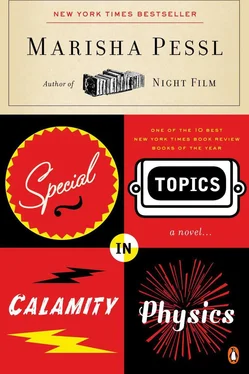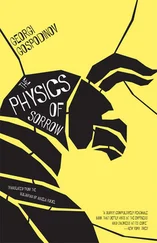Nigel was still in Hannah’s closet — he seemed to be trying on shoes — so I slipped into the adjacent master bathroom and switched on the light. In terms of décor, it was an extension of the bedroom, austere, stark as a penitentiary cell: a white-tiled floor, neat white towels, the sink and mirror meticulous, without a single splatter or smear. Words from a certain book flashed into my head, the paperback June Bug Amy Steinman had left at our house, Stranded in the Dark , by P.C. Mailey, Ph.D. (1979). The book detailed in frantic, husky prose “the surefire signs of depression in single women,” one of which was “a stark living space as a form of self-torture” (p. 87). “A severely depressed woman either lives in squalor or in a strict, minimalist living space — without anything that could remind her of her own taste or personality. In other rooms, however, she certainly might have ‘stuff’ in order to appear normal and happy to her friends” (p. 88).
I found it somewhat disheartening. However, it was when I knelt down and opened the cabinet under the bathroom sink that I was really taken aback, and I don’t think it was the same joyful disbelief Mary Leakey felt in 1959 when she stumbled upon Zinjanthropus or “Zinj.”
Inside, assembled in a pink plastic basket, was a collection of prescription bottles that made anything Judy Garland had popped in her glory days look like a few rolls of Smarties. I counted nineteen orange containers (barbiturates, amphetamines, I was chanting to myself, Seconal, Phenobarbital, Dexedrine; Marilyn and Elvis would’ve had a heyday) but, rather frustratingly, it was impossible to know what they were; there wasn’t a single label, not even evidence they’d been ripped off. On each PUSH DOWN AND TURN cap was a piece of colored tape in blue, red, green or yellow.
I picked up one of the larger ones, shaking the tiny blue tablets, each marked with a tiny 50. I was tempted to steal it, then at home, try to decipher what it was by consulting the Internet or Dad’s twenty-pound Encyclopedia of Medicine (Baker & Ash, 2000), but then — What If Hannah had a secret terminal illness and this was the treatment that kept her alive? What If I swiped one of these vital drugs and tomorrow she couldn’t take her necessary dosage and lapsed into a coma like Sunny von Bulow and I thus became the shifty Claus character? What If I had to hire Alan Dershowitz who talked about me incessantly with his mob of irksome college students who stuffed themselves with spaghetti and ginger prawns while waxing poetic on Degrees of Innocence and Guilt while my life danced in their hands like a marionette poorly rigged with sewing thread?
I returned the container.
“Blue! Come here! ”
Nigel was buried in the closet behind a few garment bags. He was one of those passionate yet chaotic excavators who shamelessly contaminated the site; he’d removed at least ten shoe boxes from the top shelf and left them heedlessly on the floor. Faded cotton sweaters had been strewn between balled up tissue paper, plastic bags, a rhinestone belt, a jewelry case, one sweat-petrified burgundy shoe. He was wearing a strand of fake pink pearls around his neck.
“I’m Hannah Schneider and I’m mys ter ious,” he said in a vampish voice, tossing the end of the necklace over his shoulder as if he were Isadora Duncan, the Mother of Modern Dance (see This Red, So Am I , Hillson, 1965).
“What’re you doing?” I asked, giggling.
“Window shopping.”
“You have to put this stuff back. She’s going to know we were here. She could come back—”
“Oh, check this out,” he said excitedly and plopped a heavy, intricately carved wooden case into my hands. Biting his bottom lip, he opened the lid. Inside glinted a silver machete approximately eighteen inches long, the sort of horrifying weapon rebels used to cut the arms off of children in Sierra Leone (“Romancing the Stones,” Van Meer, The Foreign Quarterly , June 2001). I was speechless. “There’s a whole knife collection up here,” he was saying. “She must be into S & M. Oh, I also found a picture.”
He cheerfully took back the knife (as if he were the enthusiastic manager of a pawnshop), throwing it on the carpet, and after digging through another shoe box, handed me a faded square photo.
“She kind of looked like Liz when she was young,” he said dreamily. “Very National Velvet .”
The picture was of Hannah when she eleven or twelve. It was a photo taken from the waist up so you couldn’t tell if she was outside or inside, but she was smiling hugely (frankly, I’d never seen her so happy). Her arm was mink-shrugged around the neck of another girl who was also probably quite beautiful, but she’d shyly twisted away from the camera, smiling, but blinking just as the photo was taken so you could only see into the foyer of her face (cheek, a bit of regal forehead, rumors of eyelash) and maybe a bit of parlor room (perfect ski slope nose). They wore the same school uniform (white blouse, a navy jacket — on Hannah’s, a gold lion insignia on the breast pocket) and it was one of those snapshots that seemed to have trapped not only an image but a grainy reel of life — their ponytails were full of static, stands of hair cobwebbed in the wind. You could almost hear their laughs twisting together.
And yet — there was something eerie about them. I couldn’t help but think of Holloway Barnes and Eleanor Tilden, the girls who’d conspired to murder their parents in Honolulu in 1964, subject of Arthur Lewis’ chilling nonfiction account, Little Girls (1988). Holloway killed Eleanor’s parents with a pick-ax as they slept and Eleanor killed Holloway’s with a rifle, shooting them in the face as if playing a game, hoping to win a stuffed panda, and in the photographs section in the middle of the book, there’d been a picture of the girls almost exactly like this one, the two of them in Catholic schoolgirl uniforms, their arms pretzeled, their brutal smiles piercing their faces like fish hooks.
“Wonder who the other one is,” Nigel said. He sighed wistfully. “Two people that beautiful should die. Im me diately.”
“Does Hannah have a sister?” I asked.
He shrugged. “Don’t know.”
I moved back over to the three framed photographs on the chest of drawers.
“What?” he asked, walking up behind me.
I held up the picture for comparison. “It’s not the same person.”
“Huh?”
“These photos. They’re not of Hannah.”
“Aren’t those baby pictures?”
“But it’s not the same face.”
He leaned closer, nodding. “Maybe it’s a fat cousin.”
I turned over the picture of Hannah with the blonde. There was a date written in the corner in blue pen: 1973.
“Wait,” Nigel whispered suddenly, a hand pressed to the pearls around his neck, his eyes wide. “Oh, fuck. Listen.”
The music downstairs, which had been beating with the steadiness of a healthy heart, had stopped, leaving total silence.
I moved toward the door, unlocked it and peered down the hall.
It was deserted.
“Let’s get out of here,” I said.
Nigel, with a small squeak, was already at the closet, madly trying to refold the sweaters and matching lids to shoe boxes. I considered swiping the photograph of Hannah and the other girl — but then, did Howard Carter blithely help himself to treasures in the tomb of Tutankhamen? Did Donald Johanson covertly pocket a piece of Lucy, the 3.18-million-year-old hominid? Reluctantly, I handed the photograph back to Nigel, who slipped it into the Evan Picone shoe box, standing on his tiptoes to return it to the shelf. We switched off every light, grabbed our shoes, did a final check of the room to make sure we hadn’t dropped something (“All thieves leave behind a calling card because the human ego craves recognition the way junkies crave smack,” noted Detective Clark Green in Fingerprints [Stipple, 1979]). We closed Hannah’s bedroom door and hurried down the hall.
Читать дальше












